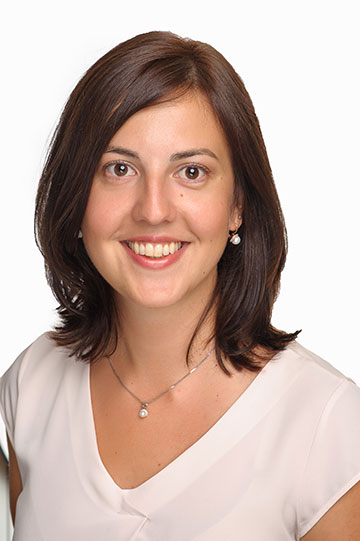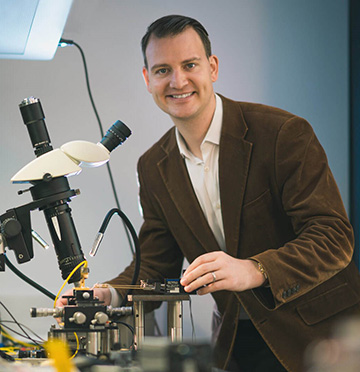
Courtesy of Marija Furdek
The OSA Advanced Photonics Congress (APC) will take place next month, from 13 to 16 July, as an all-virtual web conference for the first time. The free-for-attendees event comprises eight topical meetings that will address the many aspects of photonic device research and development and their use in networks. Optics & Photonics News spoke with two members of APC’s Strategic Planning Committee (SPC)—Marija Furdek, Chalmers Tekniska Högskola, Sweden, and Volker Sorger, George Washington University, USA—to get a feel for the scope of this year’s congress, the highs and lows of its new virtual format, and how the meeting may evolve in the future.
Furdek, who was the Chair of the Photonics Networks and Devices (NETWORKS) topical meeting from 2016 to 2019, serves on the newly formed SPC representing the NETWORKS meeting. Sorger is the committee’s chair and Board of Meetings representative.
Let’s start with some background. How did you both get interested in photonics?
Furdek: My interest in photonics started when I was a Master’s student and got to know about the amazing ability of light to carry enormous amounts of information across great distances and enable a truly connected, networked society. I was lucky to pursue a doctoral degree in what was at that time the emerging topic of optical network security, and I have been enchanted with it ever since.
Sorger: Seeing is believing, and light is simply very fascinating. Personally I’m intrigued to explore the interplay between a mathematical concept (like algorithms) and homomorphically mapping this onto photonic hardware.
What are you working on right now?

Courtesy of Volker Sorger
Sorger: I would summarize my work as photonic intelligent information processing, spanning advances on devices, circuits and systems. For instance, we demonstrated the first gigahertz-fast indium tin oxide (ITO) modulator built in silicon photonics and, at the circuit level, innovated a photonic tensor core using multi-state photonic memory, which we are now developing with industry partners. Recently, we prototyped a Fourier optics-based filter and convolutional neural network.
Furdek: My specialty is in optical network planning and optimization. Recently, I've been working primarily on cognitive management of optical network security. Together with my network of collaborators from industry and from academia, we are working on developing a framework based on machine-learning techniques for detection and counteracting service disruption attacks targeting the physical layer of optical networks.
Marija, you’ll be discussing this project during an invited talk at APC, correct? Can you share a few highlights with us now?
Furdek: In my talk, I plan to share an overview of our recent breakthroughs in the detection of physical-layer breaches using machine-learning techniques. Telecom operators are now aware that their infrastructure is left exposed and that they don't have a proper set of tools for understanding when somebody is tampering with their network and how to counteract that.

Getty Images
So we teamed up with researchers from Telecom Italia in Turin, Italy, who provided their network testbed. We subjected it to different types of attacks to really understand what happens with signal parameters when there's a breach in the network. Next, we developed different types of machine-learning techniques to understand the relationship between the different signal parameters in the presence of different attacks. We were super lucky with these experiments because we created the largest experimental dataset related to optical network security on record.
Volker, as chair of the congress’ strategic-planning committee, what do you see as the responsibilities of the committee?
Sorger: The committee has a number of responsibilities. It is tasked with the long-term planning and long-term health of the meeting itself, which includes strengthening and differentiating the congress from its competition. APC has a unique structure because it consists of several topical meetings that are all co-located, and to make it even more complex, some of these meetings are only offered every other year. The congress makeup needs to be reviewed each year, and the idea is to look for positive synergies amongst the topical meetings.
Due to the pandemic, APC 2020 will be held in an all-virtual format. Has this presented any challenges? Or opportunities?
Sorger: It's only natural that with change comes both challenges and opportunities. Of foremost importance was that we wanted to offer the same, or even improved, quality of meeting experience that our constituents expect from us. This can be achieved by ensuring quality speakers and programming, and this has not changed due to the meeting format.
There is now an opportunity for inclusion because the overhead to attend or to participate is lower in this online format. This enables students to participate who normally could only attend a limited number of meetings given finite resources. There are also increased presentation options. The new system allows us to offer different modalities of content delivery—for instance, to allow pre-recording if a live presentation is scheduled for 3:00 a.m. in the speaker’s time zone. Of course, the preferred mode of delivery is live presentation— it feels more real. But a recorded backup option is encouraged, and it takes care of the timing question.
Furdek: Obvious advantages are related to cost, time efficiency and carbon footprint. Before, attendees would take a week-long trip with long oversea flights and multi-night hotel stays, but now we have the luxury of tuning in from our offices or our homes. This shrinks the time that is occupied by the conference and drastically reduces the cost.
In a virtual conference, a much larger part of the community can afford to participate, especially those from developing countries, which I would view as the most positive effect.
How is the committee working to replicate traditional conference interactions in a virtual format?
Furdek: Some of the main challenges that we encountered are related to mapping the typical conference components into the virtual space—especially the aspects that are interactive. Being absent physically from a conference removes what I would say is the most important benefit of attending conferences—mingling, spontaneous human contact and face-to-face interactions. This is the main mechanism of expanding our professional networks. That’s why OSA is introducing a new form of interactive programming to online conferences, called “braindates,” which can be either one-on-one interaction or group interaction.
Sorger: One of the key challenges, and the reason we go to these meetings, is interaction. There are some options in the virtual format to provide this. For example, Q&As depend very much on the moderator and how much time is left at the end of a particular talk to ask questions. Now, by submitting questions during the talk and allowing other viewers to upvote the questions they want answered, the presider has a nice overview of ranked questions to ask the speaker. Similarly, the presenter has the opportunity to provide deeper answers to questions after the talk via instant messaging—which resembles chatting with the speaker after the session.
Lastly, we are experimenting with virtual rooms for posters; here, multiple people can enter a webinar-like virtual poster room where deep interactions with the presenter and other attendees takes place.
With eight topical meetings, the congress has a wide scope. Are there any unifying trends?

Getty Images
Sorger: Quantum and AI have landed at APC—that’s the big statement. APC is unique because it offers vertical R&D integration, and for quantum, it’s really like a red thread going through all these meetings, and you can see how all these knots eventually tie together. For example, emerging materials in quantum (Novel Optical Materials and Applications [NOMA]) enable devices for coherent and entangled optics (Integrated Photonics Research, Silicon and Nanophotonics [IPR]), which provide the building blocks for future quantum information processing (Photonics in Switching and Computing [PSC]) that will be implemented in fiber optic networks (NETWORKS).
Also, machines, circuits and systems are becoming smarter by the day. With the tremendous bandwidth that optics can handle, machine-learning and neuromorphic (brain-inspired) computing and information processing have arrived at APC. And there are two aspects to mention—photonics for AI and AI for photonics. Two more major themes are 5G and beyond and emerging materials.
What should attendees absolutely not miss?
Furdek: I'm definitely looking forward to hearing about different applications of machine learning in autonomous optical networking, as well as how we can establish the connection in the opposite direction—how can photonics help implement and boost performance of machine-learning techniques?
I’ll make sure not to miss NETWORKS program highlights in machine learning, optical free-space communications and terahertz technologies. In the telecom arena, it will be interesting to learn about new solutions for coping with demands on ultra-high network capacity, energy-efficiency, flexibility and automation, as well as network visions beyond 5G.
Outside of my more narrow focus of interest, I'm also looking forward to learning about the advances in quantum technologies and challenges related to their compatibility with existing telecom infrastructure. And APC has a tradition of outstanding plenary talks, so I will definitely attend those!
As members of the SPC, you’re tasked with planning for the future of this congress. What are some of your predictions?
Furdek: This is the million dollar question, something of a constant quest for a scientist—what is the next big thing? Topics related to networking that will be relevant in the coming years include opening up the network, making it more intelligent and boosting its performance. Security is definitely gaining traction, as well as new forms of mobility and new software-based solutions for autonomous network operation.
Sorger: As for topics to watch, I would keep an eye on information processing using metasurfaces and moving toward heterogeneity in computing—going from the CPU to GPU to TPU to PPU (photonic process unit). Another topic is the transition from “dumb” to “smart” AI, meaning systems that are truly adaptive and can reconfigure themselves on the fly following different machine ‘goals’ known from life-long machine-learning paradigms.
I'm making a prediction that in five years more large corporations will be looking at work presented at APC more closely. I anticipate that as machine intelligence and quantum technologies are further developed, corporations will pay attention, because APC offers this vertical pipeline toward industry connections and industry transitions. As such, APC is positioned where fiber optics was in the late 1980s, ready to ride the next AI and quantum wave.
